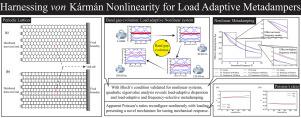Harnessing von Kármán nonlinearity for load-adaptive metadampers
IF 4.9
2区 工程技术
Q1 ACOUSTICS
引用次数: 0
Abstract
Mechanical metamaterials offer unprecedented control over wave propagation through engineered microstructures. Yet their behaviour under geometric nonlinearity and damping remains insufficiently explored. This study investigates how von Kármán nonlinearity, combined with damping, can be harnessed as a design mechanism to dynamically tune wave characteristics in periodic lattice-based metamaterials. Through nonlinear finite element simulations on regular and re-entrant hexagonal lattices subjected to distributed compressive loads, we examine changes in their band gap behaviour and deformation responses. By incorporating quadratic eigenvalue solutions, transmission losses, and iso-frequency maps, the research shows that geometric nonlinearity and damping fundamentally alter wave propagation. Under increased loading, existing band gaps diminish while new ones emerge at higher frequencies. This is accompanied by a systematic leftward and downward shift in band gap evolution due to nonlinearity and damping, respectively. Metadamping arises from the interplay between lattice geometry, nonlinearity, and damping configuration, enabling frequency-selective and load-adaptive dissipation. The study also shows that the apparent Poisson-like parameter displays nonlinear dependence on loading, reflecting microstructural deformations, and serving as an order parameter to characterise and tune auxetic behaviour in lattice metamaterials. Importantly, the applicability of Bloch’s theorem is validated in geometrically nonlinear and damped systems, extending its relevance to deformed metamaterial structures. These insights demonstrate that geometric nonlinearity and damping, rather than being limitations, can be harnessed as tunable design parameters. This work opens new directions for the development of load-adaptive metamaterials with dynamically adjustable wave-filtering and dissipation capabilities, offering broad utility in vibration control, acoustic manipulation, and impact mitigation.

利用von Kármán非线性的载荷自适应元变换器
机械超材料通过工程微结构对波的传播提供了前所未有的控制。然而,它们在几何非线性和阻尼下的行为仍然没有得到充分的研究。本研究探讨了von Kármán非线性,结合阻尼,可以作为一种设计机制来动态调整周期性晶格基超材料的波特性。通过非线性有限元模拟的规则和可重入六边形晶格受到分布压缩载荷,我们研究了他们的带隙行为和变形响应的变化。通过结合二次特征值解、传输损耗和等频图,研究表明几何非线性和阻尼从根本上改变了波的传播。在增加的载荷下,现有的带隙减少,而新的带隙在更高的频率出现。这是伴随着系统的左移和下移的带隙演变,由于非线性和阻尼,分别。元adamping源于晶格几何、非线性和阻尼配置之间的相互作用,从而实现频率选择和负载自适应耗散。该研究还表明,表观泊松参数对加载表现出非线性依赖,反映了微观结构变形,并作为表征和调整晶格超材料的形变行为的有序参数。重要的是,布洛赫定理的适用性在几何非线性和阻尼系统中得到了验证,扩展了它与变形超材料结构的相关性。这些见解表明,几何非线性和阻尼,而不是限制,可以利用作为可调的设计参数。这项工作为具有动态可调波滤波和耗散能力的负载自适应超材料的开发开辟了新的方向,在振动控制、声学操纵和冲击缓解方面提供了广泛的应用。
本文章由计算机程序翻译,如有差异,请以英文原文为准。
求助全文
约1分钟内获得全文
求助全文
来源期刊

Journal of Sound and Vibration
工程技术-工程:机械
CiteScore
9.10
自引率
10.60%
发文量
551
审稿时长
69 days
期刊介绍:
The Journal of Sound and Vibration (JSV) is an independent journal devoted to the prompt publication of original papers, both theoretical and experimental, that provide new information on any aspect of sound or vibration. There is an emphasis on fundamental work that has potential for practical application.
JSV was founded and operates on the premise that the subject of sound and vibration requires a journal that publishes papers of a high technical standard across the various subdisciplines, thus facilitating awareness of techniques and discoveries in one area that may be applicable in others.
 求助内容:
求助内容: 应助结果提醒方式:
应助结果提醒方式:


